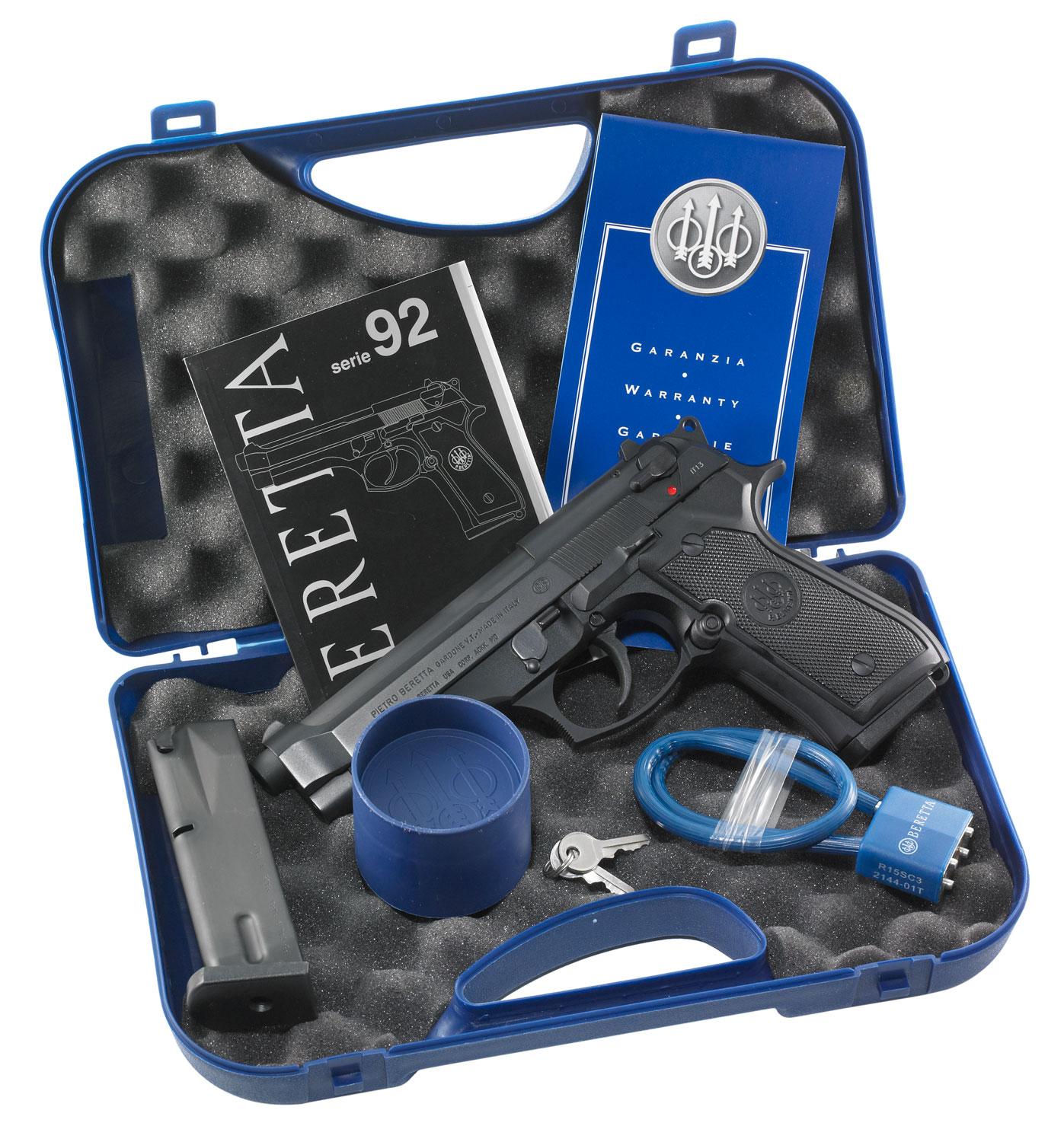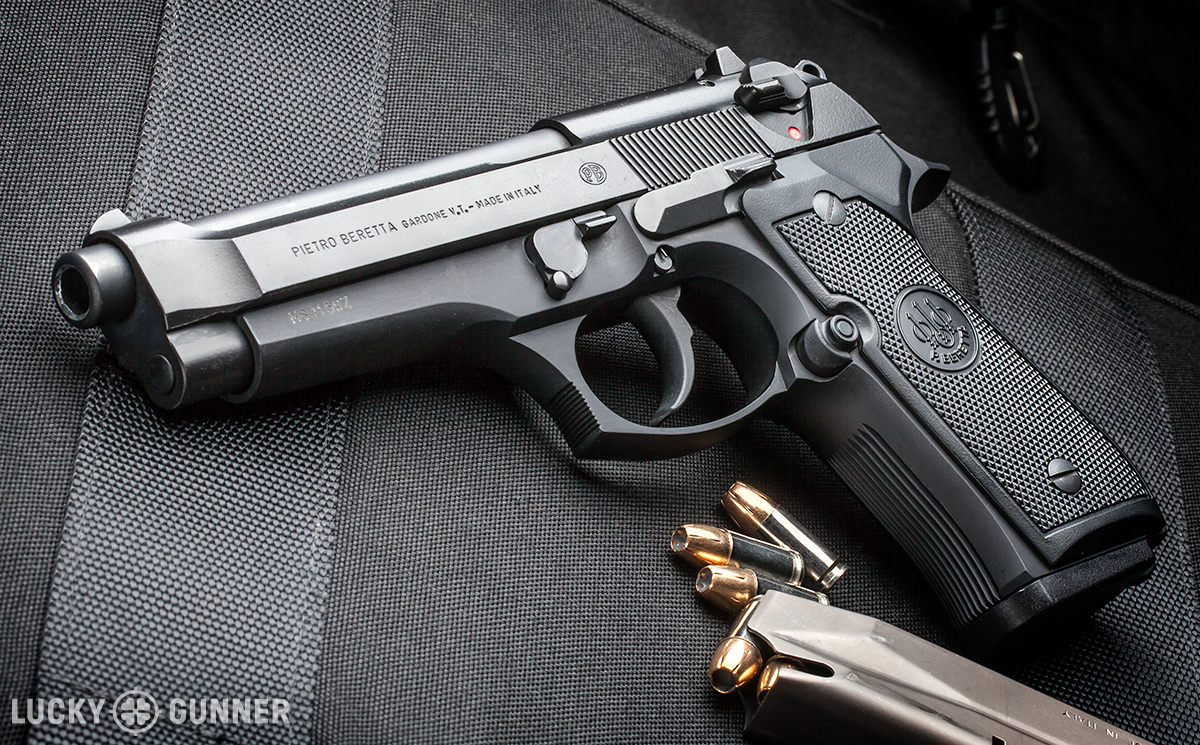Beretta M9 Ammo - The Beretta M9, officially Pistol, Semi-Automatic, 9 mm, M9, is the designation of the Beretta 92FS semi-automatic pistol used by the United States Armed Forces. The M9 was adopted by the US Army as a service pistol in 1985.
The 92FS won a race to replace the M1911A1 as the US Army's primary sidearm in the 1980s, beating out many other competitors and narrowly beating out the SIG Sauer P226 for cost reasons.
Beretta M9 Ammo

Some other pistols have seen less use, notably the SIG P228 pistol, and other models are still used in some niches.
Beretta 92fs Blank Kit
The M9 was slated for replacement under the US Army's Future Handgun System (FHS) program, which was merged with the SOF Combat Pistol program to create the Joint Combat Pistol (JCP). The JCP was rolled into a Combat Pistol (CP) and the number of pistols available for purchase was drastically reduced. The US Army, Navy, Air Force and Marine Corps are replacing the M9 with the SIG Sauer M17 and M18.
By the 1970s, all branches of the United States Armed Forces (except the United States Air Force) carried the .45 ACP M1911 pistol. The USAF chose to use the .38 Special revolvers, which were also carried by some criminal investigation/military police organizations, USAF strategic missile (ICBM) officer personnel, and military aircrew in the combat zone or to separate services. in tasks related to nuclear weapons.
The Department of Defense has decided to synchronize the weapons of the five branches of the United States Armed Forces. Service members in the ground combat branches found this arrangement highly controversial. However, it was recognized that the decision to create a common NATO pistol was made to eliminate the replacement of spent M1911 frames and to simplify logistics (under the conditions of the war against the Soviet Union in Europe). . In 1979, the Joint Service Small Arms Program began searching for a replacement for the verbal M1911, and the 9×19mm Parabellum round was selected to meet the NATO Standardization Agreement (STANAG) . In 1980, the Beretta 92S-1 was selected from several models from Colt, Smith & Wesson, Walther, Star M28 and Fabrique Nationale and Heckler & Koch.
However, the result was questioned by the US Army and the military conducted new tests. In 1984, testing began again with updated attempts from Smith & Wesson, Beretta, SIG Sauer, Heckler & Koch, Walther, Steyr and Fabrique Nationale. Beretta won this competition, but in 1988 a new test appeared, the XM10 Competition. This led to two separate experiments that were more limited but resulted in the Beretta chos, albeit with an updated design.
Gun Review: Taurus Pt 92 Af 9mm Pistol
Beginning in 1979, while pistol selection processes were running in parallel, holster company Bianchi International began developing a multi-purpose military holster ready for the launch of a new pistol. The resulting holster was designed by John Bianchi and Richard Nicholas and was called the M12. The M12 has served the US military well for decades and was adopted at the same time as the Beretta 92FS was adopted in 1985.
The Beretta 92FS passed a series of survival tests that included: exposure to temperatures ranging from -40 to 140°F (-40 to 60°C); salt water corrosion testing; repeated drops on concrete; and buried in sand, mud and snow. Additionally, the 92FS demonstrated 35,000 rounds (average rounds before failure), a number often cited as five or six times the pistol's life. Although this usually is
The Iraq War, which featured frequent close-quarters and urban combat, required American soldiers to rely more on their guns.

The M9 is a short-recoil, semi-automatic, single/double-action pistol that uses a 15-round stepped box magazine with a reversible magazine release button that can be positioned for both right- and left-handed shooters . The M9 is used with the Bianchi M12 holster, although other holsters are often used. Specific modifications to the Beretta 92 include:
Beretta 92fs 9mm Full Size 15 Round Pistol
There is also a large hammer pin that fits into a slot on the bottom of the slide. The main purpose is to prevent the slide from flying backwards out of the frame if it cracks. This was added after Beretta models were observed to have very high bullet count slide defects during testing (the defects were later determined to be caused by defective ammunition used in testing).
The M9 has multiple internal safeties, including a firing pin block that prevents the firing pin from moving without the trigger being pulled, and a firing pin stop that rotates when the safety lever is depressed, preventing the firing pin from firing when dropped the hammer The M9 also features an ambidextrous external safety lever that allows left- and right-handed users to engage or disengage the safety mechanism.
Among other things, he added a single-slot Picatinny rail for lights, lasers, and other accessories to the gun. The M9A1 features a more aggressive fore, aft belt check and an inclined magazine for easier reloading of the weapon. The M9A1 pistols are sold with a Physical Vapor Deposition (PVD) coated magazine that was developed to better withstand the sand conditions of the Iraq and Afghanistan wars.
The M9 22LR is a version of the M9 chambered in a .22 long rifle and has the same action, controls and disassembly as the M9. The M9 22 is available with 10- and 15-round magazines, removable sights, and interchangeable grip panels that fit the Beretta M9.
Hfc Beretta M9 Gbb Full Metal
The M9 has been the standard sidearm of the United States Navy, United States Army, and United States Air Force since 1985, replacing the Colt M1911A1 in the Army and Navy and the Smith & Wesson. 38 Special to the Air Force. The M9A1 is also a limited issue for the US Marine Corps.
A large number of M9s and M9A1s were ordered in 2006. During the 2009 SHOT Show, Beretta announced that it had been awarded a $220 million contract to supply 450,000 M9s and M9A1s to the US military over five years.
The Beretta M9 General Officer Model is a special model issued to Army and Air Force General Officers.
Which replaced the Special Edition RIA M15 Chief Officer's Pistol and the Colt M1911A1 Colt M1911A1 beginning in 1986. It is identical to the standard M9 sidearm, standard Bruniton polymer finish, and black composite grip, except that a prefix is added "GO" in the series. Range of numbers starting with GO-001. It has a metal belt buckle which is available in gold metal for army generals and silver metal for air force generals.
Beretta Px4 Storm Full Size Ammo Armor (9mm & .40cal)
The Marine Corps Times reported in July 2007 that officers below the rank of colonel and all SNCOs will be issued M4 carbines instead of M9s.
The new allocation policy continues to assign M9s to Marine Corps colonels and above and Navy officers first class and above.
The US Coast Guard has replaced most of its M9 pistols with the SIG P229 DAK, although some M9s remain in service with some units.
On September 30, 2011, Beretta USA announced that the US Army's Foreign Military Sales Program had purchased an additional 15,778 Model 92FS pistols for the Afghan military and other US allies.
Tfb Review: The Italian Surplus Beretta 84bb Pistol The Firearm Blog
In September 2012, Beretta USA announced that the US military had purchased 100,000 M9 pistols and that the M9 "will remain their weapon of choice for the next five years".
Before it was widely adopted by the US military, questions were raised in a 1987 General Accounting Office report after a malfunctioning Beretta 92SB slide injured a member of the Special Operations Forces of the Navy
And two more errors were later observed during further testing. These failures included both military and civilian Beretta models with very high ammo counts, and upon investigation, Beretta determined that they were the result of US military-supplied ammunition exceeding NATO recommended pressures . Instead, the US military concluded that the defects were caused by the low hardness of the metal of the Italian-made slides. However, this incident led to changes in the design of the M9 to ensure that slide failure would not cause injury to the user, after which no further slide breaks were reported.

In December 2006, the Cter for Naval Analyzes released a report on US small arms combat. The CNA surveyed 2,608 soldiers who returned from combat in Iraq and Afghanistan in the past 12 months. Only those troops who fired their weapons at enemy targets could participate. 161 soldiers were armed with M9 pistols, representing 6% of the survey. 58% of M9 users (93 soldiers) reported satisfaction with the weapon, the lowest satisfaction rate in the survey. 48% of users (77 soldiers) were dissatisfied with M9 ammunition. 64% (103 soldiers) were satisfied with handling characteristics such as size and weight. M9 users had the lowest level of satisfaction with the weapon's performance, including 76% (122 soldiers) with accuracy, 66% (106 soldiers) with range, and 88% (142 soldiers) with a cadence of fire. Of those who used the M9, 48% (77 soldiers).
Mm Vs 40 Vs 45
Toy beretta m9, beretta m9 msrp, beretta m9 holster safariland, beretta m9, beretta ammo bag, beretta m9 leg holster, beretta m9 extended mag, beretta m9 vs 92fs, beretta m9 shoulder holster, beretta m9 holster, beretta m9 military, beretta m9 disassembly
0 Comments